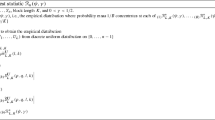Abstract
The aim of the paper is to determine when the periodic block bootstrap, procedure introduced by Chan et al. (Technometrics 46(2):215–224, 2004), can be applied to arrays of random variables. Formal consistency is obtained under α-mixing or m-dependence conditions together with the assumption that the length of the period tends to infinity. On the other hand, if the period is constant, inconsistency is shown. The performance of periodic block bootstrap is also compared in simulations with moving block bootstrap. It is suggested that for the case of long-period data the first method is more effective and much more stable with respect to the length of the block size.
Similar content being viewed by others
References
Araujo A, Giné E (1980) Central limit theorem for real and Banach valued random variables. Wiley, New York
Berk K (1973) A central limit theorem for m-dependent random variables with unbounded m. Ann Probab 1: 352–354
Bloomfield P, Hurd H, Lund R (1994) Periodic correlation in stratospheric ozone time series. J Time Ser Anal 15(2): 127–150
Carlstein E (1986) The use of subseries values for estimating the variance of a general statitics from a stationary sequence. Ann Stat 14(14): 1171–1179
Chan V, Lahiri SN, Meeker W (2004) Block bootstrap estimation of the distribution of cumulative outdoor degradation. Technometrics 46(2): 215–224
Dahlhaus R (1997) Fitting time series models to nonstationary processes. Ann Stat 25(1): 1–37
Gardner W, Napolitano A, Paura L (2006) Cyclostationarity: half a century of research. Signal Proc 86(4): 639–697
Gerr N, Hurd H (1990) Graphical methods for determining the presence of periodic correlation. J Time Ser Anal 12: 337–350
Gladyshev EG (1961) Periodically correlated random sequences. Sov Math 2: 383–388
Gonçalves S, White H (2002) The bootstrap of the mean for dependent heterogeneous arrays. Econ Theor 18: 1367–1384
Hurd H (1989) Nonparametric time series analysis for periodically correlated processes. IEEE Trans Inf Theor 35: 350–359
Hurd H, Leśkow J (1992) Strongly consistent and asymptotically normal estimation of the covariance for almost periodically correlated processes. Stat Decis 10: 201–225
Kim TY (1994) Moment bounds for non-stationary dependent sequences. J Appl Probab 31: 731–742
Künsch H (1989) The jackknife and the bootstrap for general stationary observations. Ann Stat 17(3): 1217–1241
Lahiri SN (1999) Theoretical comparison of block bootstrap methods. Ann Stat 27(1): 386–404
Liu RY, Singh K (1992) Moving blocks jacknife and bootstrap capture weak dependence. In: LePage R, Billard L (eds) Exploring the limits of bootstrap. Wiley, New York, pp 225–248
Politis D, Romano J (1994) Large sample confidence regions based on subsamples under minimal assumptions. Ann Stat 22: 2031–2050
Politis D, Romano J, Wolf M (1999) Subsampling. Springer, New York
Radulović D (1996) The bootstrap of the mean for strong mixing sequences under minimal conditions. Stat Prob Lett 28: 65–72
Romano J, Wolf M (2000) A more general central limit theorem for m-dependent random variables with unbounded m. Stat Prob Lett 47: 115–124
Singh K (1981) On the asymptotic accuracy of the efron’s bootstrap. Ann Stat 9: 1187–1195
Sjoestedt S (2000) Resampling m-dependent random variables with application to forecasting. Scand J Stat 27: 543–561
Synowiecki R (2007) Consistency and application of moving block bootstrap for nonstationary time series with periodic and almost periodic structure. Bernoulli 13(4): 1151–1178
Vecchia A, Ballerini R (1991) Testing for periodic autocorrelations in seasonal time series data. Biometrika 78: 53–63
Author information
Authors and Affiliations
Corresponding author
Additional information
Work partially supported by the following grants: NATO Collaborative Linkage Grant no. ICS.NUKR.CLG 983335, AGH local grant no. 10.420.03, EC FP6 Marie Curie ToK programme SPADE-2 at IMPAN, Warsaw.
Rights and permissions
About this article
Cite this article
Leśkow, J., Synowiecki, R. On bootstrapping periodic random arrays with increasing period. Metrika 71, 253–279 (2010). https://doi.org/10.1007/s00184-008-0228-x
Received:
Published:
Issue Date:
DOI: https://doi.org/10.1007/s00184-008-0228-x




